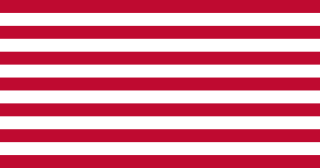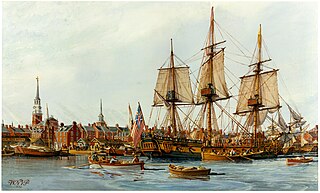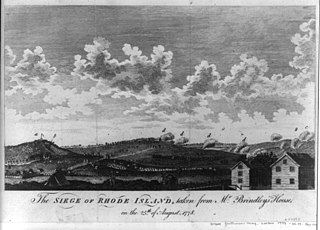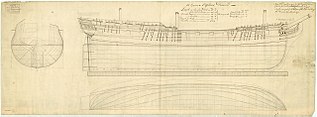
The Continental Navy was the navy of the Thirteen Colonies during the American Revolutionary War. Founded on October 13, 1775, the fleet developed into a relatively substantial force throughout the Revolutionary War, owing partially to the substantial efforts of the Continental Navy's patrons within the Continental Congress. These Congressional Patrons included the likes of John Adams, who served as the Chairman of the Naval Committee until 1776, when Commodore Esek Hopkins received instruction from the Continental Congress to assume command of the force.

USS Ranger was a sloop-of-war in the Continental Navy in active service in 1777–1780, the first to bear her name. Built at Portsmouth Naval Shipyard on Badger's Island in Kittery, Maine, she is famed for the one-ship raiding campaign by Captain John Paul Jones, during naval operations of the American Revolutionary War. In six months spent primarily in British waters she captured five prizes, staged a single failed attack on the English mainland at Whitehaven, and caused Royal Navy ships to be dispatched against her in the Irish Sea.

Alfred was the merchant vessel Black Prince, named for Edward, the Black Prince, and launched in 1774. The Continental Navy of what would become the United States Navy acquired her in 1775, renamed her Alfred after 9th century English monarch Alfred the Great, and commissioned her as a warship. She participated in two major actions, the battle of Nassau, and the action of 6 April 1776. The Royal Navy captured her in 1778, took her into service as HMS Alfred, and sold her in 1782. She then became the merchantman Alfred, and sailed between London and Jamaica.

USS Raleigh was one of thirteen ships that the Continental Congress authorized for the Continental Navy in 1775. Following her capture in 1778, she served in the Royal Navy as HMS Raleigh. The ship is featured on the flag and seal of New Hampshire.

The Mount Hope Bay raids were a series of military raids conducted by British troops during the American Revolutionary War against communities on the shores of Mount Hope Bay on May 25 and 31, 1778. The towns of Bristol and Warren, Rhode Island were significantly damaged, and Freetown, Massachusetts was also attacked, although its militia resisted British attacks more successfully. The British destroyed military defenses in the area, including supplies that had been cached by the Continental Army in anticipation of an assault on British-occupied Newport, Rhode Island. Homes as well as municipal and religious buildings were also destroyed in the raids.
USS Spitfire may refer to the following ships of the United States Navy:

The Battle of Rhode Island took place on August 29, 1778. Continental Army and Militia forces under the command of Major General John Sullivan had been besieging the British forces in Newport, Rhode Island, which is situated on Aquidneck Island, but they had finally abandoned their siege and were withdrawing to the northern part of the island. The British forces then sortied, supported by recently arrived Royal Navy ships, and they attacked the retreating Americans. The battle ended inconclusively, but the Continental forces withdrew to the mainland and left Aquidneck Island in British hands.

HMS Orpheus was a British Modified Lowestoffe-class fifth-rate frigate, ordered on 25 December 1770, as one of five fifth-rate frigates of 32 guns each contained in the emergency frigate-building programme inaugurated when the likelihood of war with Spain arose over the ownership of the Falkland Islands. Sir Thomas Slade's design for Lowestoffe was approved, but was revised to produce a more rounded midships section; the amended design was approved on 3 January 1771 by Edward Hawke's outgoing Admiralty Board, just before it was replaced. The contract to build the Orpheus was awarded to John Barnard at Harwich, the keel being laid in May 1771, and the frigate was launched 7 May 1773, at a cost of £12,654.16.11d. She sailed from Harwich on 24 May for Sheerness Dockyard, where she was completed and fitted out to the Navy Board's needs by 11 June.

The fourth HMS Diamond was a modified Lowestoffe-class fifth-rate frigate ordered in 1770, launched in 1774, but did not begin service until 1776. Diamond served off the eastern North American coast and shared in the capture at least one brig during the American Revolutionary War. The frigate was paid off in 1779, but returned to service the same year after being coppered. Diamond sailed to the West Indies in 1780, was paid off a final time in 1783 and sold in 1784.

Pierre Douville was a French-Canadian naval captain and lieutenant who served in the American Revolution and French Revolution. Born on present day Prince Edward Island, Douville survived the 1758 Acadian deportation to France. He joined the French Navy and lived in Rhode Island during the American Revolution. During the American Revolution, he served as a French military intelligence officer who provided General George Washington with British ship and troop movements. Douville also took part in a smuggling mission in 1775, when he brought weapons and gunpowder from the French West Indies to the United States. Douville was one of the original members of the Society of the Cincinnati. Douville died in 1794 fighting for the French during the Glorious First of June.
HMS Nonsuch was a 64-gun third rate ship of the line of the Royal Navy, built by Israel Pownoll and launched on 17 December 1774 at Plymouth. She was broken up in 1802.

Vestale was a Blonde-class 30-gun frigate of the French Navy. The Royal Navy captured her in 1761, but had to scuttle her in 1778 to avoid having the French recapture her. She was refloated and sold to the French in 1784. She returned to wartime service in 1794 as a privateer. The British recaptured her in 1798 and broke her up thereafter.
The second Providence, a 28-gun frigate, built by Silvester Bowes at Providence, Rhode Island, by order of the Continental Congress, was launched in May 1776.

USS Fly was an eight-gun sloop in the Continental Navy. She was part of a squadron that raided the port of Nassau and engaged the 20-gun HMS Glasgow.

American colonial marines were various naval infantry units which served during the Revolutionary War on the Patriot side. After the conflict broke out in 1775, nine of the rebelling Thirteen Colonies established state navies to carry out naval operations. Accordingly, several marine units were raised to serve as an infantry component aboard the ships of these navies. The marines, along with the navies they served in, were intended initially as a stopgap measure to provide the Patriots with naval capabilities before the Continental Navy reached a significant level of strength. After its establishment, state navies, and the marines serving in them, participated in several operations alongside the Continental Navy and its marines.

The Rhode Island State Navy was the first colonial or state navy established after the American Revolutionary War began in April 1775 with the Battles of Lexington and Concord. On the following June 15, the General Assembly authorized the acquisition of two ships for the purpose of defending the colony's trade. The state's ships were generally used for defensive operations within Narragansett Bay, although some prizes were taken. The state was also one of the first to authorize privateering.

During the American Revolutionary War, the Georgia State Navy consisted of only a few ships, most of which were destroyed in 1778 and 1779.

HMS Kingfisher was the second ship in the 14-gun Swan class of ship sloops, to which design 25 vessels were built in the 1760s and 1770s. She was launched on 13 July 1770 at Chatham Dockyard, and completed there on 21 November 1770. She took part in the American Revolutionary War, enforcing the blockade of the Delaware Bay, and served in the Battle of Turtle Gut Inlet, near Cape May, New Jersey. While under the temporary command of Lieutenant Hugh Christian, she was burnt by her own crew to avoid capture on 7 August 1778 in Narragansett Bay during the Battle of Rhode Island.
Two vessels of the Royal Navy have borne the name, HM galley Pigot. Both were acquired in 1778 during the American Revolutionary War, and both were lost that year; her crew destroyed the first to avoid her capture, and the Americans captured the second. Both were named for General Sir Robert Pigot, the general commanding the British Army at Newport, Rhode Island, during their service there.
HMS Greenwich was the American privateer Greenwich that HMS Maidstone captured on 20 April 1778. She served for a little more than a year, particularly at Georgia, before she was burnt in May 1779.











